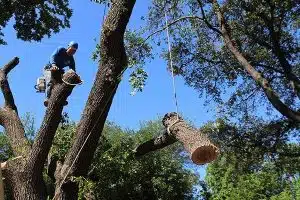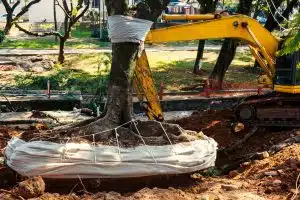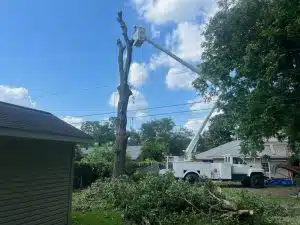The expense of tree removal is an important topic for homeowners, property managers, and anybody in charge of preserving outdoor spaces. Trees, with their magnificent appearance and numerous benefits, are invaluable assets to any landscape. However, there are occasions when tree removal is necessary. Whether due to illness, safety issues, encroachment on property structures, or landscaping purposes, tree removal requires a combination of skill, equipment, and associated costs.
Different Factors that Influence the Cost of Tree Removal
The abundance of trees on our properties provides natural beauty, shade, and quiet. However, there are times when removing a tree is necessary. Understanding the economic ramifications of tree removal is crucial for both homeowners and property managers, whether it’s due to safety concerns, illness, or landscaping preferences.
The cost of tree removal can vary substantially depending on numerous essential factors, and understanding these features will help you plan and budget for the removal procedure.
Tree Size and Variety:
Tree Size: The size of a tree is a major cost driver. Larger trees typically necessitate more labor, equipment, and time. Tall trees or those with large canopies often demand the use of specialist equipment such as cranes or aerial lifts for safe and effective removal.
A 30 feet or shorter can generally expect to pay an estimated range of $300 to $500 for removal services. medium-sized trees ranging from 30 to 60 feet, fall within the price range of $600 to $1,000 for removal. For larger trees, around 60 to 80 feet in height, the cost can substantially increase, within the range of $1,500 to $3,000.
Tree Type:
The wood density and branch architecture of different tree species vary. Some species, such as oaks and maples, can be more difficult to remove due to their hardwood, whilst others, such as pines, may be relatively easier. Tree species can influence the time and effort necessary for removal.
Location:
Proximity to Structures: Trees located near homes, buildings, electrical lines, or other structures necessitate careful planning and, in many cases, more labor-intensive ways to assure safety and prevent property damage. This proximity can greatly raise the final cost.
Accessibility: Making machinery and personnel more accessible can reduce the time and effort required for removal, making it more cost-effective. In contrast, trees in difficult-to-reach regions may necessitate additional manual labour, raising the expense.
Health and Condition:
Disease & Infestation: Trees infected by diseases or infestations may require particular precautions during removal to minimize pathogen spread. This can necessitate specific disposal procedures, protective equipment, and additional care, all of which add to the expense.
Structural Integrity: Trees that are structurally weakened or damaged may represent a greater risk during removal. Safely removing such trees necessitates specific techniques, which might raise the expense.
Tree Height and Diameter:
Height: Taller trees are more difficult to remove and may require specialized equipment for cutting and lowering limbs. The height has a direct impact on labour expenses and equipment needs.
Thickness A thicker trunk requires more effort and time to topple and remove the tree. It may also necessitate greater machinery, adding to the expense.
A number of trees:
Removing numerous trees in a single project can frequently be more cost-effective because it lowers setup and cleaning time. Many tree removal businesses provide discounts for large-scale removals.
Stump Removal:
The removal of the tree stump and roots adds to the project’s costs. Depending on your preference, stump removal may involve stump grinding or excavation, both of which require specialized equipment.
Debris Removal:
Clearing the debris generated during tree removal, such as branches, leaves, and logs, is an important aspect of the operation. You can tackle this yourself, but engaging pros for cleanup raises the whole cost.
Permits and rules:
Permits for tree removal may be required by local rules and tree protection ordinances, and these permits frequently include additional fees. Compliance with such regulations is required and may increase the project’s cost.
Emergency or Hazardous Tree Removals:
If a tree is posing an urgent hazard, such as leaning dangerously or being destroyed in a storm, emergency removal may be required. It usually cost $5000. These scenarios frequently necessitate faster response times and specialized equipment, which incurs more costs.
Cleanup and Site Restoration:
The level of cleanup and site restoration desired following removal can vary. Some homeowners may prefer a basic cleansing, but others may require additional services such as ground leveling or tree planting. These extra charges for post-removal services might mount up.
Professional Knowledge:
Hiring licensed arborists or experienced tree removal specialists ensures more skill and safety during the removal process. While this may increase the cost, it provides peace of mind as well as great service.
How Tree Removal Costs Can Be Reduced?
Obtain quotations from several tree removal firms. Compare their prices and services to determine the most cost-effective alternative. Plan tree removal for the off-season (typically late fall or winter). Many tree service firms provide discounts this season.
Combine tree removal with other tree-related services such as pruning or stump grinding. This can result in cost savings when services are grouped together.
Instead of eliminating all trees, try selective removal. Keep healthy and aesthetically valued trees and only remove those that are unhealthy, hazardous, or negatively influence your property.Offer to do the cleanup and disposal of tree debris yourself. This can drastically reduce labor costs.
If trees on your land encroach on a neighbor’s property, discuss cost-sharing alternatives with your neighbor, especially if the trees are causing problems on both sides.
Check for any municipal programs or incentives for tree preservation or removal. Some localities give cash incentives for tree preservation. Consider recycling or selling the wood from the removed trees to offset some of the removal costs.
FAQS
How much does tree removal normally cost?
The cost of tree removal varies greatly depending on factors such as the tree’s size, location, health, and the services necessary. It might cost anywhere from a few hundred dollars to several thousand dollars.
What are the key elements impacting the cost of tree removal?
The key elements influencing tree removal costs include the tree’s size and height, its location and accessibility, its health and condition, the services required (e.g., stump removal), and local labour rates.
Are there set costs for tree removal services?
No, there are no set or standard pricing for tree removal because each tree and situation is unique. Costs are calculated following an inspection by a tree removal firm based on specific characteristics connected to your tree.
Are healthy trees less expensive to remove than diseased or dead ones?
In general, healthy trees are less expensive to remove than ill or dead trees since they are easier to work with and pose fewer risks. However, the size and position of the tree continue to have an impact on the cost.
Are there any other fees than the base tree removal fee?
Yes, there may be additional fees for services such as stump removal, debris cleanup, and disposal.
Conclusion
The cost of tree removal is varied and dependent on several factors, making it difficult to establish a definite estimate. The final cost is determined by factors such as tree size, location, health, and other services. It’s best to connect with a professional tree removal firm to examine your specific issue and acquire an accurate estimate. You can effectively reduce your tree removal costs by considering cost-cutting techniques and selecting a trustworthy provider.




